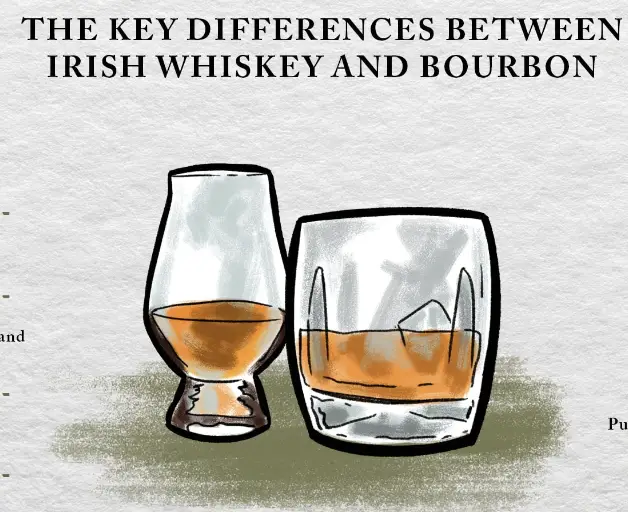
Irish Whiskey vs. Bourbon: Exploring the Richness of Two Iconic Whiskies
Whisk(e)y enthusiasts are familiar with the allure and complexity of different styles of this beloved spirit. When it comes to comparing Irish whiskey and bourbon, two renowned whiskies with distinct origins, production methods, and flavor profiles, the journey becomes even more fascinating. In this blog post, we will delve into the unique characteristics of Irish whiskey and bourbon, highlighting their differences and exploring the rich world of flavors they offer.
- Origins and Production: Irish Whiskey: Irish whiskey has a long and storied history, dating back centuries. It is renowned for its smoothness and triple distillation process. Irish whiskey is typically made from a blend of malted and unmalted barley and distilled in pot stills or column stills. The spirit is then aged in oak barrels for a minimum of three years, resulting in a light and approachable whiskey.
Bourbon: Bourbon, on the other hand, is deeply rooted in American heritage. To be legally considered bourbon, it must be produced in the United States and made primarily from corn (at least 51%). Bourbon is distilled using a continuous column still or a pot still and is aged in new, charred oak barrels. The aging process imparts the whiskey with distinctive caramel and vanilla notes, contributing to its rich flavor profile.
- Flavor Profiles: Irish Whiskey: Irish whiskey exhibits a smooth and mellow character. It is known for its light, fruity, and floral flavors with subtle hints of honey, vanilla, and malt. The triple distillation process contributes to its clean and delicate profile, making it an approachable choice for both seasoned whiskey enthusiasts and newcomers to the category.
Bourbon: Bourbon showcases a bolder and more robust flavor profile. Its prominent corn base lends it a sweet and full-bodied taste, with notes of caramel, vanilla, oak, and sometimes a touch of spice. The charred oak barrels used in aging impart additional complexity, adding smoky and woody undertones that enhance the overall flavor experience.
- Maturation and Aging: Irish Whiskey: Irish whiskey is typically aged for a minimum of three years, although many expressions are aged for longer periods. The aging process in used or ex-bourbon barrels allows the whiskey to develop subtle nuances from the wood, creating a balanced and harmonious flavor profile.
Bourbon: Bourbon must be aged in new, charred oak barrels. The aging process is a critical factor in bourbon production, and the minimum legal requirement is two years, although most bourbons are aged for significantly longer periods. The charred oak imparts distinct flavors and impurities are filtered out during the aging process, resulting in a smooth and refined whiskey.
- Regional Influences: Irish Whiskey: Irish whiskey production has a rich history influenced by traditions and regional styles. Different regions in Ireland, such as Cork, Dublin, and Midleton, have their unique approaches to whiskey production. These regional distinctions contribute to the diversity within the category, offering a wide range of flavors and characteristics.
Bourbon: While bourbon must be produced in the United States, there is no specific regional influence comparable to that found in Irish whiskey. However, specific regions within the U.S., such as Kentucky, have become synonymous with bourbon production due to their historical significance and concentration of distilleries. Kentucky bourbon is known for its deep, rich flavors and cultural significance.
- Culinary Pairings and Cocktails: Irish Whiskey: The light and approachable nature of Irish whiskey makes it versatile in various culinary pairings and cocktail creations. It pairs well with light cheeses, seafood, and desserts with fruit or caramel flavors.Bourbon: Bourbon’s robust and sweet profile makes it a fantastic companion to rich and savory dishes. It pairs well with smoked meats, grilled steaks, and dishes with bold flavors. In cocktails, bourbon shines in classics like the Old Fashioned, Mint Julep, and Whiskey Sour.
- Cultural Significance and Heritage: Irish Whiskey: Irish whiskey has a deep-rooted cultural significance and a reputation for craftsmanship. It has been distilled in Ireland for centuries and holds a prominent place in Irish heritage and folklore. The spirit’s historical significance adds to its allure and evokes a sense of tradition and craftsmanship.
Bourbon: Bourbon carries a rich cultural heritage, deeply ingrained in American history. It is associated with the American South, particularly Kentucky, which is known as the birthplace of bourbon. Bourbon’s popularity has spread globally, becoming a symbol of American craftsmanship and tradition.
Conclusion: Irish whiskey and bourbon offer unique and captivating experiences for whiskey enthusiasts. While Irish whiskey impresses with its smoothness, lightness, and floral notes, bourbon captivates with its bold flavors, rich caramel, and oak undertones. Both whiskies showcase centuries-old traditions, regional influences, and cultural significance that add depth to their appeal. Whether you prefer the delicate elegance of Irish whiskey or the robust complexity of bourbon, exploring these whiskies allows you to appreciate the craftsmanship, history, and flavors that make each one an iconic choice. Indulge in the richness of both Irish whiskey and bourbon, and savor the remarkable journey of flavors they offer.



